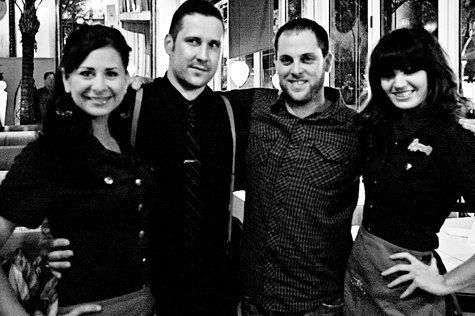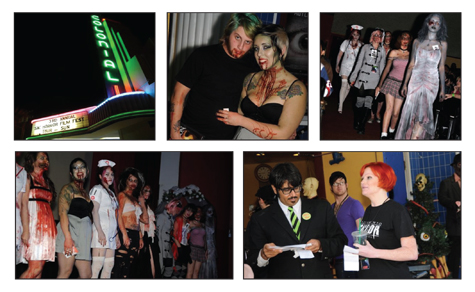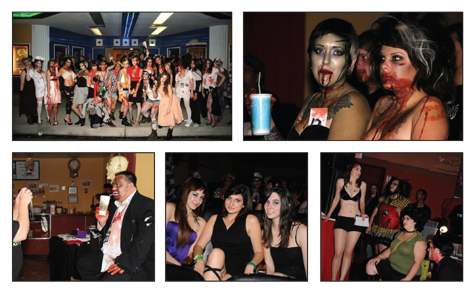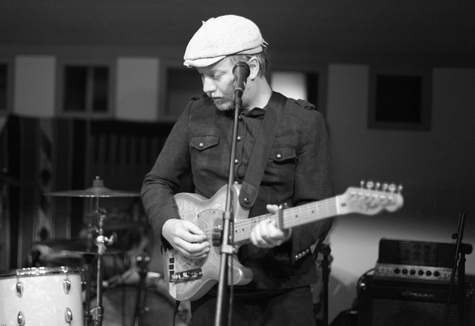In what may be the most bizarre story ever involving a local musician, J.P. Hunter of the local sleaze-rock outfit Get Shot! went on record early last week admitting that he was in fact the man who threw the infamous hot dog at Tiger Woods at the Frys.com Open golf tournament last weekend in San Martin, Calif., a stunt that made national news. Hunter did numerous radio interviews including one that I caught on Oct. 11, 2011 on the widely listened-to Mark & Brian program, where he explained that his band had a show in Reno, Nev., the night before and that he’d been “drinking Jameson all day” and that he and a band mate got free passes to the tournament from some girls while hanging out at a Starbucks. “I just kept on drinking and drinking,” Hunter told Mark & Brian. “I was surprised I got past security,” he said. The interview lasted a few minutes and was rather light-hearted and funny and Hunter got to, of course, plug his band while explaining why he allegedly threw a wiener at the world’s most famous golfer. Where this story takes a weird turn, as if it isn’t already odd enough, is that just a couple days later a multitude of legit news outlets from all over started reporting that the hot dog thrower wasn’t Hunter of the band Get Shot! at all, it was instead 31-year-old Brandon Kelly of Petaluma, Calif. Numerous sources confirmed it and Kelly did a number of interviews himself where he shared that the movie Drive, of all things, inspired his hot dog chuck at Tiger. After scrounging up video of the incident on YouTube (search “Spectator throws hot dog at Tiger Woods”), it’s quite apparent that it’s not Hunter throwing the dog. The dude on the video is husky and has a full head of hair; Hunter is skinnier and has a shaved head. Either way, hot dog toss or not, you’ve got to admit that it was a pretty genius way for Hunter to plug his band and get tons of free press via major radio outlets. Look for Get Shot! shows posted on their facebook page. And expect things to get weird, as they tend to do during Get Shot! shows. Hunter told Mark & Brian during his (fake) interview, “At our shows, we throw a lot more than hot dogs at the crowd.” And there you go, Get Shot!, even more free press.
Tag Archives: Sacramento
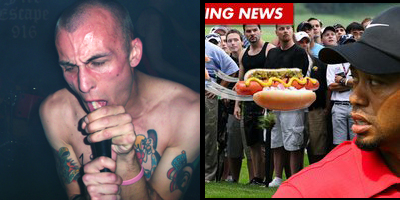
Did A Local Rocker Throw The Hot Dog At Tiger Woods?

Old Beast Learns New Tricks
Mastodon thunders across the United States on strength of The Hunter
Over the past decade, Mastodon has established itself as one of the premier forces in American metal. Among critics and fans, the Atlanta-based band has become as huge and monolithic as its name suggests. In 2009, Mastodon showed once again that it had brains equal to its brawn with the release of Crack the Skye, a soaring concept album (in a string of concept albums) in homage to drummer Brann Dailor’s sister Skye who took her own life when she was just 14. Crack the Skye was lauded by critics, and the accolades translated into sales as well. The album debuted at No. 11 on the Billboard Top 200 and also afforded the band the opportunity to tour Europe with Metallica, hit the road with grunge icons Alice in Chains as well as conduct their own headlining tours here and abroad. How would Mastodon follow up the success? Shake up the establishment, of course. They hired a producer better known for hip-hop than progressive sludge metal and ditched their penchant for high concepts to create their most straightforward and accessible album to date, The Hunter, released on Reprise Records Sept. 27, 2011. For those afraid that Mastodon may have Bob-Rocked themselves like their aforementioned European tour mates, fear not. This is not the Mastodon you know and love, but it packs just as mammoth a punch.
You won’t find a lot of math for math’s sake on The Hunter, but Mastodon’s sound is unmistakable. Opening track “Black Tongue” is the Mastodon you remember, just condensed into a roughly three-and-a-half minute burst of ferocity. From there, the album takes a sharp turn into “Curl of the Burl,” where Dailor and crew ditch the intricate progressions and time signature manipulations for heavy-riffed southern-fried rock. What follows is space-age weirdness (“Stargasm”) seated at the same table as beautifully wrought metal epics (the title track). What becomes apparent from listening to The Hunter is that Mastodon are as capable as ever, even when they’re not going out of their way to flaunt their impressive chops.
Submerge had the opportunity to interview Dailor while the band was in preparations for their upcoming headlining U.S. tour, which kicks off Oct. 25, 2011 in Austin, Texas. Dailor says that the band will be unleashing perhaps “the longest set list that we’ve done” at stops on the tour.
“We’re probably doing six or seven songs off the new record, and then a whole bunch of other ones,” he says. “I think we’re doing 23 or 24 songs total.”
Now five albums deep, Dailor says that the band has a lot of material to choose from making the decision of what makes the cut live more difficult, but the band doesn’t just take themselves into account when they hit the road. He explains that he and his band mates keep tabs on fan chatter on message boards and elsewhere to see which songs are getting the most reaction.
“When we’re writing an album, that’s for us,” Dailor explains. “We just try to concentrate on what we like. I feel like the show is more about the fans. It’s about us as well, we want to play the songs we like, but we make sure that we love the songs first and foremost when we put them on the record, but what people are responding to, we make sure to play those live.”
Mastodon will bludgeon through Sacramento on Nov. 2, 2011. In anticipation of the upcoming show, Dailor took some time to converse with us about The Hunter and gave us some insight into the making of it.
I wanted to take it back to 2010 when you guys did the Jonah Hex soundtrack. I read in an interview that you said that was the first time you tried a spontaneous recording process like the one you tried with The Hunter. You said that it gave you guys the confidence to work that way. Why did you go more spontaneous with the Jonah Hex project as opposed to what you’d done in the past?
We didn’t have time to do anything but. We had two weeks in Los Angeles, in a studio, and we were just going in there every day and seeing what we could come up with. That was the plan from the beginning with that, because we really didn’t have time. We were on tour…we were in Europe for three months with Metallica, and we were pretty much fried. We had three weeks off between tour, and those three weeks were supposed to be us going home and chilling out because we’d just run ourselves through the wringer in Europe. Instead, we headed to L.A. … There wasn’t a lot of time to sit and work stuff through for six months. It just wasn’t that type of thing. It was a lot of fun doing that, because you get used to doing things a certain way, and I don’t know if it’s superstition or whatever, but you get used to it because it’s worked in the past. We wanted it to be something that we dug and were proud of, but when you’re writing for a movie soundtrack, it’s not something you can get married to, because it’s not your decision if it gets used or not. It’s a different thing. You have to sort of write music and let it go. We were providing some riffage for their movie and handing it over, so to speak.
So it definitely wasn’t the same mindset you’d go into the studio with when you make a Mastodon record?
No, and that’s not to say that we weren’t going to put our stamp of approval for it, because we did enjoy some of the stuff that came out. But it wasn’t the same thing. A Mastodon album is a different thing. Even though I talked about the new record being more spontaneous–and it was, and I think the Jonah Hex thing did give us some confidence in ourselves that we could just write stuff on the spot and have it come out good–but it wasn’t the same thing. A lot more work went into The Hunter, obviously.
Some of The Hunter was written on the road with Alice in Chains. Was that something new for you guys?
Yeah, kind of. It’s happened a couple of times before. There have been some things that have been written that have come together in sound checks and stuff like that. Somebody will start jamming something and someone will start playing along, and we’ll all say, “Hold on, what’s that? Let’s make sure we don’t lose that. Are you going to remember that? Maybe we can record it real quick, because that’s awesome.” But this time wasn’t the first time, but it seemed like it was happening a lot more often. We had road crew that would go and grab the practice amps and set them up, and they’ll just be back there with a guitar plugged in ready to go… When Brent [Hinds, guitar/vocals] or Bill [Kelliher, guitar] wander back stage, and there’s a guitar and an amp set up and ready to play, they just pick it up and start playing. That started happening every day. I’d pick up my iPhone and hit record if I heard something cool, if I heard something worth our while. If it wasn’t for the iPhone, this record wouldn’t have come together so quickly.
A lot of artists expressed remorse for the passing of Steve Jobs. Was that something that affected you at all?
Absolutely. It’s sad. I feel bad for his family. It’s always sad to lose a loved one when you feel like it’s too soon. His mind, he was one in a million, one in I don’t know how many millions, but we all lost a great thinker and idea person. There just aren’t enough idea people, you know?
The Hunter was dedicated to a couple of people the band lost during the recording of the album. The title is a nod to Brent Hinds’ brother Brad who passed away. Other than the title, did that play into the writing of the album?
I think it did in the aspect of the way the record sounds, the way the record came together. Brent and I were going down there every day. There were a lot of things happening not just with Brent, but with the other members of the band that were really stressful. Where in the past, making a Mastodon record was a really stressful thing, we were banging our heads against the wall trying to fit all this mathematical craziness into the middle of a song. It could be six months of fine-tuning and going in there and getting frustrated and all that stuff. I guess with everything that was going on on the outside, we really wanted the practice space to be a fun place to go and be the one place you could go and close the door and leave everything outside… I think that has a lot to do with the way the album sounds. It’s kind of stripped down. We would write a straight-up rock song like “Curl of the Burl” and be done with it and not care what anyone would think.
We dug it, it was fun. I think it had a lot to do with just the lightheartedness we wanted to approach everything within the practice space. We knew everyone was a little fragile, a little hurting inside, and we didn’t want to make the practice space the stressful place it can be because of all the other shit that was going on outside.
Mastodon will play Ace of Spades on Nov. 2, 2011. This is a stacked lineup that will also feature Red Fang and The Dillinger Escape Plan (fuck yeah!). Be sure to buy your tickets in advance. They can be purchased through Aceofspadessac.com for $28. Doors open at 6 p.m. for this all-ages show.
Real World Treasure Hunt to Win a 2012 Chevy Sonic on Nov. 5, 2011

On Saturday, Nov. 5, 2011, a 2012 Chevy Sonic will be up for grabs in downtown Sacramento! The Chevy Sonic Adventure presented by the Northern California Chevy Dealers is a one-day, real world treasure hunt around the downtown area where all the locations and challenges will be delivered straight to your cell phone. Grab a teammate, solve challenges and earn points to win a brand spankin’ new ride. To sign up to play, visit Chevysonicadventure.com and use the codeword “Submerge17” to guarantee your spot. The “treasure hunt” starts at 9 a.m. at the west steps of the State Capitol, and following the event there will be an awards ceremony also taking place at the Capitol’s west steps at about noon. There is no cost to play and bikes are not allowed–everyone must play on foot (or by medically necessary wheelchair). Now go get that car!
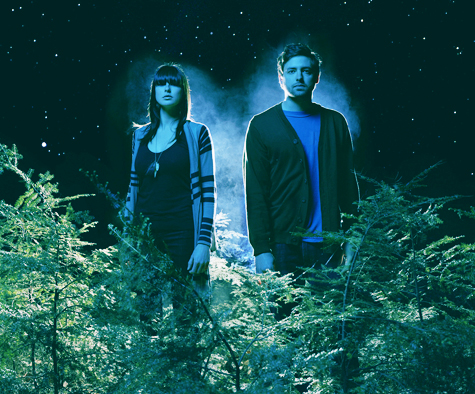
Best Foot Forward
Phantogram Moves in the Right Direction
Formed in 2007, New York’s Phantogram is just starting to hit its stride. The band, based out of the quaint rural town of Saratoga Springs, is the brain child of Sarah Barthel and Josh Carter. The two have been lifelong friends, but just started making music together relatively recently. Just last year, the duo released its debut full-length, Eyelid Movies, on indie label Barsuk, and Phantogram has more or less been hitting the road to promote it ever since. This fall, Carter and Barthel are set to hit the road again on a month-long headlining tour that will coincide with the release of a new “mini album” titled Nightlife.
Carter hasn’t been taking the rigors of being a band on the rise lightly. Submerge’s first attempt to call the band’s songwriter for our interview was left unanswered. As it turned out, the interview occurred a few hours later. An apologetic Carter confided in us that he was out for a run during our scheduled interview time–an effort to “change up my lifestyle a bit,” he said.
“I’ve been smoking a pack a day for about 10 years–of Newports, nonetheless. That’s like the worst cigarette you can smoke,” Carter explained. “I just want to get healthy, you know? I feel like it will be good for my music. I’ve spent a lot of time on the road drinking way too much and drugging and smoking.”
Carter said he started running about two weeks prior to our phone call. Though he hasn’t been able to cut out the cigarettes just yet, he seemed determined to kick the habit.
“I’m on Chantrix, so hopefully I don’t murder anybody,” he said plainly.
Though this is a new regimen for him, he said he thinks it will ultimately not only improve his well being but also improve his potency as a songwriter.
“People have told me they hit this stride–well, it was my dad, actually–they hit this stride where it clears their minds,” Carter said. “That hasn’t happened yet, but I think it’s going to be a good balance for my life and help my creativity.”
He’ll need all the clarity he can get with the band’s upcoming schedule. The most recent headlining tour, which begins Oct. 20 in Millvale, Penn., will take Phantogram through some cities it hasn’t been to before, such as Santa Fe, N.M.; Baton Rouge, La.; and Houston, Texas. Carter said that he’s looking forward to the challenges of winning over new faces.
“I’m curious as to what kind of draw we’ll have or not,” he said. “But it’s fun to hit up new cities, and sometimes it’s pleasantly surprising, and sometimes it’s just what you expect, like, ‘OK, no one’s ever heard of us here,’ but a show is a show. And either way, we enjoy playing.”
The tour comes on the heels of an eight-week stint that wrapped up in mid-August and an appearance at this year’s Bumbershoot in Seattle in early September. On top of that, Carter said he has an “itch to create” that compels him to be “constantly writing music or making beats.” In fact, Carter said he’s already looking forward to getting back to the studio to make another full-length Phantogram album.
Until then, there’s the matter of Nightlife, which Carter told us would be released the first week of the tour. He called it a bit of a departure from Eyelid Movies, though “it points in that direction.” As far as direction goes, it’s difficult to pin down where Phantogram’s moody songs are coming from. Hip-hop beats bump and grind behind Barthel’s dream pop vocals, while guitar lines slither through a forest of lush synths. He elaborated on why Nightlife may have a more of a raw sound than its predecessor and hinted at what direction Phantogram may be headed in the following interview.
I read a recent live review of your band, and the reviewer said that he’d seen you before, but now you really seem to be coming into your own. Do you feel that on stage? You and Sarah have known each other forever, but are you really noticing a stronger bond when you perform live?
I just think that we’re a new band. We’re pretty young. I just think that we’re getting better at it. I don’t know if you’re a musician or an artist or whatnot, but it takes time to really hit your stride and get in your groove with those sort of things. I think we’re getting better and better every day as a band, and it’s been a lot of fun. We’ve hired a drummer, a friend of ours named Tim Oakley, and that makes it a lot of fun live. I really don’t know what to say. Whoever wrote the review could have seen us as a two-piece and then saw us with the live drums and felt that dynamics change or whatever, but it’s all about just kind of doing it a lot.
Why did you decide to add a live drummer to the mix?
We envisioned our sound to be bombastic and loud, but after a while of playing as a two-piece, we got sick of being just a two-piece, looking at each other. I had played in a few bands before, and I’d turn around and there’d be no one behind me. It was a lot of fun as a two-piece, like, juggling around with the beats and sampling, but we just wanted to add more texture, more dynamic to the live show. We thought having a drummer would make it a lot punchier.
I’d seen the video clip of you guys at the Moog headquarters recording “16 Years.” It’s a really cool video, and it must have been a lot of fun getting to play with all that equipment.
We were like kids in a candy shop, you know? Playing with all that cool, analog gear was so much fun, but as much recording and producing that I do, I’m still not a gearhead, per se. It takes me longer to figure out things, and we had limited time, but we had a lot of fun with what we chose to use. We made a pretty cool rendition of that song, I think. Everybody at Moog was super friendly. They sent us a Little Phatty synthesizer too for doing that, which was amazing. I had a blast, and we got to see the factory. It was in the factory, and I had never realized how much of a boutique company it is. They only had 10, 15 people tops working in there, testing out the oscillators by hand. Their equipment is expensive, but you can really see why because there’s so much attention to detail.
How did that come about?
They asked us to be part of their series that they wanted to start. Since they knew we were into synthesizers and thought we would be a cool band to have.
Earlier you mentioned that the new EP is in some way a departure from Eyelid Movies. Why do you think it’s a departure?
It’s definitely in the same vein to a degree, but when I listen to it, I hear a lot of emotion. I hear a lot of emotion in Eyelid Movies too, but it’s raw. It’s a bit more…hmm…I don’t know. I don’t really listen to our music that often. I wish I could compare and contrast, but it’s rawer, and it feels very emotional to me. Maybe it’s just a departure for me because it’s new. I guess we’ll have to wait and hear what other people think.
Was it the subject matter of the songs that make the new release feel more raw?
It’s really dark subject matter when I write our songs. I write a majority of our music and write the lyrics to our music. This year for me and Sarah–I’m not going to elaborate, so don’t bother asking–but it hasn’t been the easiest year on us emotionally. It’s been a great year for us being in a band, but we’ve gone through a lot of ups and downs. The subject matter hits really hard, really close to home for me.
You said you’re really looking forward to doing another full-length next. Have you put any thought into that yet?
Not exactly hunkering down. Just about every night of the week, I’ll hunker down and work on something, but we do at the moment have a mission statement for the next album. But I’m such a flaky person that that could change in a second. I expect the next album to have a lot more separation sonically. I sort of picture things–and both of us do when we write our music–in a visual sense. Right now we’re thinking really stark, high-contrast black and white. But who knows? Maybe we’ll put out this super duper layered, drone-y, shoegaze, hip-hop, whatever-the-fuck psychedelic record. I don’t know.
Could you share that mission statement?
I think we should keep it under wraps, because it could change.
Mystery is better anyway.
We both listen to so much different kinds of music that we’re not influenced by anything in particular. I think after touring with The XX and listening to that new James Blake record, I really like the idea of more separation, and I guess minimalism to a degree.
Phantogram’s headlining tour comes through Sacramento on Nov. 1, 2011 at Harlow’s. Showtime is 8 p.m. and tickets ($15) can be purchased through Harlows.com. Reptar will also be performing.
Shake, Muddle and Stir
Sacramento Embraces Craft Cocktails
Words by Adam Saake – Photos by Nicolas Wray
With Midtown Cocktail Week just barely behind us, the craft cocktail resurgence seems to have hit Sacramento full-blown. The customer dialogue has changed from, “Well is fine” to “What gins do you have behind the bar?” And curiosity isn’t far behind. These more educated enjoyers of quality spirits want to know what it is, what’s in it, and where can I find it? Put down the Puckers and pick up the muddlers; freshness now reigns supreme. The usual suspects have been holding down the artform for some time; familiar names like Lounge on 20, Shady Lady and Ella come to mind. But now it’s tough to throw a rock and not hit a Collins glass with Green Chartreuse somewhere inside of it. The result is a plethora of interesting cocktails to be sampled, and everyone’s getting in on it.
Bartenders are stepping up to this challenge and becoming more educated themselves; many of them entering competitions locally and beyond to sharpen their skills and test their hands at speed or flair. Brands often endorse these competitions, encouraging bartenders to experiment with their spirits and create something interesting that may be marketable. Wowing the judges takes more than just making a tasty cocktail; technique and presentation is key and often-homemade garnishes or unique glassware help set the competition apart.
One such competition at Zocalo that happened recently challenged local bartenders to think creatively with the coffee and rum liqueur Kahlua. Chris Dooley of Ella, Travis Kavanaugh and Dominique Gonzales of Shady Lady and Amy Battaglia of The Golden Bear were among the chosen few to try out their cocktail recipes for a panel of judges. Dooley’s personality shone bright through his cocktail he named “The Veracruz,” after the Mexican state where Kahlua is produced. Made up of Kahlua, fresh espresso, bitters, Fernet Blanca, Bulleit bourbon and garnished with mint, orange, nutmeg and shaved chocolate, this stunning cocktail was a sight to behold.
“Well, Kahlua for me personally is a dessert, after-dinner cocktail. So everything in there screams ‘after dinner’; the digestif [Fernet], the espresso, the Kahlua, the chocolate,” said Dooley.
Dooley served it in a stemless martini glass that rested in another oval-shaped glass filled with frozen espresso beans to keep the drink chilled. The “Veracruz” landed Dooley in second place, but the experience of being able to toy around with Kahlua, a liqueur that bartenders rarely experiment with, was worth it.
“I like to explore the diversity of it; to be able to try different applications,” Dooley expressed.
But in the end it wasn’t the Kahlua that threw Dooley for a loop.
“Anything I can add Fernet into is a challenge for me,” said Dooley.
First place was awarded to Midtown Cocktail Week’s “Rookie of the Year” Travis Kavanaugh of Shady Lady for an 11-ingredient cocktail that took 11 tries to get just right. He named it “Nuevo,” fittingly, and the judges might have scored it just that high on a scale of one to 10. Kavanaugh says that “for about a week, all I did was mess with Kahlua.” The result was a seemingly impossible blend of Kahlua, rye whiskey, Angostura bitters, orange bitters, maple syrup, Heering cherry liqueur, pineapple, egg white, nutmeg, orange zest and muddled coffee beans. Kavanaugh served his cocktail in a 5½ ounce coupe glass, which meant that all those ingredients had to be combined in very limited amounts to get the cocktail to fit just right. And although it took 11 tries and one week later to arrive at his final product, he enjoys the challenge of figuring out how to make it all work.
“I like competitions. Anytime I have something to mess with and break it down and just use it for a whole week, I think is really cool,” says Kavanaugh.
The time that is spent off the clock, at home or after hours, perfecting a syrup or portioning out the recipe just right, is what separates bartenders like Kavanaugh and Dooley from the rest. They aren’t alone. And bartenders who work at restaurants that may not be on the top of your craft cocktail destination list are starting to follow suit. Take, for example, Lucca bartender Chris Mansury, who is doing some very interesting things behind the bar.
Fascinating things have been done with the Bloody Mary in this town, including some amazing heirloom tomato Bloody Marys done by Chris Tucker at the now closed (sadly) L Wine Lounge. But, Mansury is taking it to a new level. His concoction is called the Hanoi Jane, which he says is a “Vietnamese-inspired version of the Bloody Mary using pho broth, Sriracha, garlic, basil and green onion.” If that isn’t enticing enough, he then salts the rim with a beef jerky salt he made and then garnishes it with basil, lime and jalapeno.
“I created it as a combination of two of my favorite hangover cures,” says Mansury.
Another interesting notable is Mansury’s Pear Basil Highball that he’s spiked with something called a shrub.
“A shrub is basically a syrup made of fruit, sugar and vinegar in equal parts,” says Mansury. “Shrubs derive from the Persian sherbert [sharbaat] which is widely regarded as the world’s original soft drink.”
Forget about pre-prohibition, Mansury is tapping into some old-school stuff here. His shrub is essentially simple syrup that’s a lot brighter with the addition of apple cider vinegar. He adds the classic combination of bourbon and ginger ale and the end product is a refreshing and balanced cocktail that screams end of summer, beginning of fall.
It goes beyond the simple “what do I have behind my bar,” and becomes a process of research and study that is fueled by passion (and maybe a few too many taste tests) where the goal is to make something handmade and unique; to discover a combination that works. The competitions are good inspiration, a way to stand out and crash course a particular spirit, but mostly it’s a love for blowing a customer’s mind when they try something they’ve never experienced before. Maybe it sounds a little geeky, but everything high-tech and cool that you own is the result of some guy or some gal sticking their nose way deep down the rabbit hole. Cocktails may not be high-tech per se, but the more out-there the ingredients and flavors get, the more challenging it becomes to make it all work together. Hence the term, “mixology.” Don’t expect to see beakers in the place of shakers, but the science of it all will be perfect for wetting that whistle.

Grab some pumpkins to carve and get lost in a giant corn maze at Dave’s Pumpkin Patch
Dave’s Pumpkin Patch in West Sacramento is just minutes from downtown Sacramento and is the only full-sized themed corn maze in the area. Grab some pumpkins to take home and carve and stay past sundown and venture into the corn maze. Every Friday and Saturday night in October, Fright Night will even “haunt” the maze with some of their actors all dressed up in character, as if getting lost in a giant corn maze when it’s pitch black isn’t freaky enough. Don’t forget your flashlights (unless you are really hardcore). Also notable: on weekends they do their “Punkin’ Chunkin” every so often where they cannon pumpkins over 500 yards through the air! Take an old-fashioned hay ride, get your little ones’ faces painted, watch pig races and more. Dave’s Pumpkin Patch is located at 3010 Burrows Avenue, West Sacramento and can be reached at (916) 849-9450 or online via Davespumpkinpatch.com

Scream your ass off at Fright Planet Haunted Theme Park at Cal Expo – 2011
Fright Planet is really stepping it up in 2011 with their haunted theme park at Cal Expo (gate 9 off Ethan Boulevard at the former Paradise Island Theme Park). There are five massive themed haunted houses: Pirates of Scurvy Island, Dead Man’s Lagoon in 3-D, Death Row, Blackout! and Psycho Midway in 4-D (“terrorific scents” add the fourth dimension according to their website, Frightplanet.com). Each haunted house attraction is about 5,000 square feet. There’s also a 100-seat “ScreamMax” theater where you can catch a 25-minute 3-D movie featuring “spectacular 3-D effects and a frightful soundtrack.” There really is something to scare everyone, even you tough guys out there, at this hell-ish (in a good way) theme park. Claustrophobic? You might want to avoid Blackout!, where you really can’t see shit and there are “hidden scares.” Hate clowns? Stay the heck away from the Psycho Midway! All Fright Planet cast members–there are a whopping 150 of them–have to go through a formal audition process and attend “Scare School” before they step foot into a haunted house to scare you and your friends. Their set painter is even a retired Disneyland artist, so everything looks realistic. Fright Planet is open now until Nov. 2, 2011, check their website for times and for tickets (which range in price from $19.95 to $35) call 1-866-666-1313 or visit Frightplanet.com
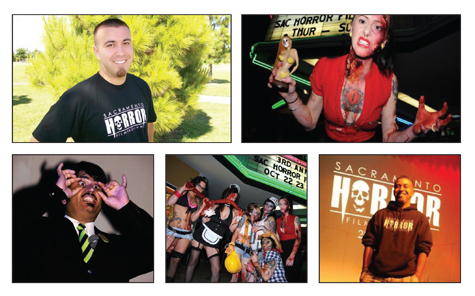
Things that Go Bump in the Night
The Sacramento Horror Film Festival returns to swallow your soul
Hamsters can make the perfect family pet. They are very cute, very fuzzy and very thirsty for human flesh. The fluffy monsters will kill your friends and terrorize your neighborhood as they cackle and stare into your soul with their beady red eyes. If you turn your back on them, they will eat you from the inside out, showing no mercy. At least they will according to Tim Meunier’s favorite short horror film, Night of the Hell Hamsters. This cheesy horror film, along with hundreds of other frightening flicks, is part of the Sacramento Horror Film Festival, a four-day event that is ready to kick off Halloween. But this is not your average film festival; not only is it fully loaded with independent films, it also contains shorts, documentaries, music videos, animations, live music and even the Zombie Beauty Pageant.
Since 2007, Meunier, the founder, director, programmer and head of staff of the popular growing festival, somehow finds time to work a full-time job and view every single horror film that is entered into the festival–all 4,800 of them!
“I watch every film that rolls through the doors and as soon as the festival is over, I start accepting entries again. So it’s a year-long process,” Meunier said over the phone after working a long, “chaotic” day. “Of course a lot of people wait until the last minute so it gets a little hectic.”
Throughout the year of watching those flicks, Meunier’s trained eye looks past the blood, guts and killer hamsters to catch the numerous aspects of each film. He watches for production quality, editing, acting, direction and most importantly originality of the storyline.
“My goal in the festival is to show entertaining films that you are going to remember and to promote new talent that can hopefully move on to make bigger films,” he added. “Every movie in the festival I am a personal fan of and I think that somebody will like it because I liked it.”
But in a dwindling economy, this horror film lover struggles with cash flow. After five years of finding cash sponsors to support the event, this will be the first year that the entire four days of horror will be funded by Meunier himself. He and his staff also struggle to find appropriate places to advertise for the event.
“We’ve been turned away from some businesses because of the type of event. We get treated like the unwanted child of the film festival community,” he said.
Advertisers might be hard to find these days, but the fans are not. Meunier and his staff have garnered a following called the “little horror family” in the Sacramento area. The turnout for the festival has ranged from 1,000 to 2,500 people for one weekend. “It’s like a reunion every year for some of these people and it feels good. We have some die-hard fans.” Every year the staff can expect to see the same faces returning to support the festival. In the past, one Sacramento resident parked his RV in the parking lot in order to be the first person in line for the films and entertainment.
“Our crowd is the Horror Film Festival. I don’t know what it is or if it’s something they put in the popcorn, but we have very vocal crowds, they are very boisterous. It’s almost like all day is a midnight screening,” Meunier said. “It’s not your typical film festival environment.”
The Sacramento Horror Film Festival is one of the many horror related events that have a similar fan base in the Sacramento area, including Trash Film Orgy, Vampire Ball, Rocky Horror Picture Show and Evil Dead: The Musical. “I wouldn’t be able to be doing what I’m doing today without the support of a lot these other groups. I give them props and shout outs,” Meunier said. “Without them I don’t know if I would have had a following. My fans are their fans and their fans are our fans.”
The horror family for the film festival has found a “cozy little joint” to call home at the historical Colonial Theatre. The atmosphere of the old venue speaks for itself. “It’s a one-screen theater, and they have pro-wrestling matches there every month. So sometimes the concrete is a little red-stained from whatever matches they had. It has a creepy, rough environment, so it’s very fitting.”
In the beginning, the idea of the festival started off with Tim doing a little research and asking questions of film festival directors around the country, including Greg Ropp, president of the Eerie Horror Film Festival in Pennsylvania and Nathan Schemel, local director of the Sacramento Film and Music Festival. “When I first started I didn’t know there wasn’t a horror film festival in town,” Meuinier said. “I just Googled stuff. I wasn’t involved in the film community that much, I didn’t know if there was a demand for it. I didn’t know if five people were going to show up or 500 people were going to show up.” As a former paranormal activity group member, Meunier found friends that were willing to help out with the cause and after five years he has kept the majority of the same staff members. Over the years, the 32-year-old has learned that some of the best independent or big screen horror flicks have some of the lowest budgets behind them. “A lot of these films require using friends and family. It’s like, ‘Hey mom, do you want to get killed in this scene?’ Even the big Hollywood horror films are nowhere near the budget of the Avatar’s. I don’t know if I’ve ever seen a $150 million horror film,” he said. “But it’s great practice for independent filmmakers to make low-budget films, because they are still going to have to cut corners, even if they make it big.”
Whether it’s Nightmare on Elm Street or Night of the Hell Hamsters, the Sacramento Horror Film Festival wants to leave you with one thought: that horror films are made for an audience to scream at, jump at and even laugh at. “When I get scared I love it. It’s like a drug to me. I don’t drink, I don’t do drugs, I’m addicted to horror. It should never be taken seriously. To me it’s the fun house mirror of society. It’s taking real issues and giving a funny take on it, a unique take, splashing some fake blood on the situation, or amplifying the situation to make it easier to deal with. That’s what the horror film is.”
The Sacramento Horror Film Festival takes over the Colonial Theatre from Oct. 20—23, 2011. Tickets for each event can be purchased a la carte at the door for $10 or an all-events pass will cost just $30. For a full rundown of all that the SHFF has to offer, or to purchase an all-events pass, go to Sachorrorfilmfest.com.

Don’t Mind the Dark
Garrett Pierce taps the healing powers of lyrics on his new EP
Envision sitting on a boat along a murky jungle river in a downpour of a storm in Guatemala, watching the river boat captain try to navigate the boat, except for the fact that he is lost.
This wouldn’t seem like a time for laughter.
But for semi-local songwriter Garrett Pierce, the moment could not have been more perfect.
“I just started laughing. It’s one of those epiphany moments where things that were built up from my time in San Francisco were just kind of built up and went down that water,” he remembers.
These are the heavy emotions that often play out in Pierce’s songs.
This October, Pierce is releasing a four-song collection on the EP Everybody Breaks under Narnack Records, which will be followed by his full-length City of Sands, which is set for release in January or February 2012.
Everybody Breaks is both melancholic and uplifting. At times it feels like reading a diary in the gray of winter. “In Silence” is sung over the sound of a warped organ, while “Shape Us Like Waves” is a rich composition in which Pierce sings, “We are people of the coast, so we know that the waves can break if we make it so,” in a dreary ode to the Bay.
What has been a constant is Pierce’s passion for writing. His musical beginnings were fostered in Southern California, starting when his dad bought him his first acoustic guitar around age 12.
“The first thing I did was write, which was very strange. He wanted me to take lessons and learn blues guitar, but I had no interest in shredding, I guess. I just wanted to write,” he said. “It hasn’t really changed since then.”
Growing up in what is considered either the armpit or artistic mecca of California, depending upon your outlook, Pierce has immersed himself into music from a young age.
First he went through a grunge phase that morphed into a hard rock phase by the time he joined a rock band in high school.
Pierce remembers when he first dabbled with writing acoustic-based songs after moving back to Los Angeles.
“Everybody was trying to be Jewel or John Mayer or something on the acoustic guitar, and it was a terrible time for me because I had all these songs. I just didn’t feel like I had an audience yet,” he said.
It was during this time that a friend invited Pierce to move to Davis to start playing music.
He laughed at the question and asked, “Why on Earth would I move from L.A. to Davis?”
As it turned out, he said it ended up being the best move of his life. He established his roots as a songwriter and connected with the likes of Davis experimental indie band Sholi as well as Michael Leahy, a KDVS host and founder of Crossbill Records, which would eventually put out Pierce’s first two albums, Like a Moth and All Masks.
“L.A. was not the place for me, there was just all these people trying to cut you record contracts down there,” he said.
Davis provided something that L.A. didn’t. There was a tight-knit musical community and he could play his songs where people would listen to him as a songwriter. And it was at this time that other lyrically creative, acoustic-based performers like Joanna Newsom and Devendra Banhart began to garner attention in the music world.
“That was just a totally great time to be playing music,” he said.
Nowadays, Pierce finds himself again adjusting to new territory, this time in Sonoma.
When Submerge caught up with Pierce over the phone, he had just gone for a five-mile run through the oaks and pines.
It sounds like you’re an advocate of having strong lyrical content.
Oh yeah, that’s the biggest thing for me. It doesn’t mean I don’t listen to music that doesn’t have lyrics. Thirty Three is one of my favorite bands, and they don’t have a singer. For me, it’s really important that people who are interested in my music think of it first as a lyrically based form, that writers are my biggest influences, taking from people like Steinbeck and Richard Wright, they are my biggest influences… Lyrics are huge, and shaping the right mood of the song around the lyrics is the most important thing.
Everybody Breaks struck a chord with me, both the EP as well as the song. You said some of these songs are older, but I was interested in knowing what you were feeling at the time you wrote “Everybody Breaks.”
That’s a tough one. I was talking to Nathan, our publicist, and just describing the songs to him, and I realized that the EP sounds pretty and it sounds uplifting even at times, but the lyrical content is on the darker side. I was thinking of long-term relationships and thinking about the body breaking down and all these dark feelings started coming together into one mass. I was listening to a lot of John Jacob Niles, an old soul folk singer, and my buddy who is Ellie Fortune, they both have this really nice, rootsy, folk guitar playing style. So I based the vibe of the song around this sparse guitar picking, and then the lyrics were just trying to lift me out of a funk of just thinking about the end of things.
And what about “A Bus in Africa?”
I was listening to NPR, and I heard this horrendous story, about–I think it took place in Uganda, if I’m correct–about this group of people in a bus who got pulled to the side by child soldiers, and pulled out of the bus and taken out at gunpoint, and people were put underneath the bus, and the bus driver was [forced] to get back in and run over the people, over and over. It was the most disturbing thing I had heard all year, and I couldn’t get it out my head, the image was terrifying to me.
For me, it’s harder to talk about those things sometimes. You don’t just want to bring it up in a conversation like that with your friends. So I take myself to a place where I can find out what was really happening in the minds of some of those people on the bus. It’s a first-person account, for some reason it’s the only way I could think to write it, and the chorus, like a lot of my songs, it’s not purely dark. The chorus has this amazing, positive chant, “That’s what love is for.” And it sounds very strange in juxtaposition to the lyrics that talk about these bandits that are killing everybody. But this person [has] this mantra of love for his family and why you need to have love so you don’t turn into these monsters that were taking the lives of people around them.
You were in an experimental noise band, 60 Watt Kid…
[Laughs] You have done some pretty good research. Where did you get that information from?
It’s amazing the things you find online. It looks like you were the drummer, and I listened to it, and I thought, “Man, what prompted this drastic change from you being in an experimental noise band to being a folk singer/songwriter?”
Well, actually those were concurrent. I was still playing plenty of solo stuff, but my whole goal when I moved to San Francisco was to be able to play my own music and kind of make a living from it… I just ran into them randomly at a bar in Oakland, and they said they were looking to hang out with new people and play music. He and this guy Derek had started this band 60 Watt Kid, and I invited them to play a couple shows with me. They were looking for a drummer, and I said, “Hey, I think I know how to play drums. And I’ll play with you guys until you find somebody.” And we just ended up clicking really well. The songs actually started more acoustic-based. We were like a lot of people at the time, we were listening to a lot of Animal Collective and it definitely showed in some of the earlier recordings. And then it just kind of got crazy… We would play characters on stage too, and dress up in sparkly weirdness. And I would kind of go caveman crazy on the drums. I was playing all four toms and a cymbal, and a tambourine around my ankle. It was not very complicated drumming, it was that caveman tribal stuff. It was so good to be physical, and we would break stuff and yell at each other’s faces. It was more Andy Kaufman, honestly. It was wild and it was so much better than standing with an acoustic guitar for me, for a little bit. It was a performance aspect I had missed since I was in rock bands in high school.
Garrett Pierce’s Everybody Breaks is out now on Narnack Records. He’ll celebrate the release in Sacramento on Oct. 21, 2011 at Bows & Arrows. Look for his new full-length album early next year.
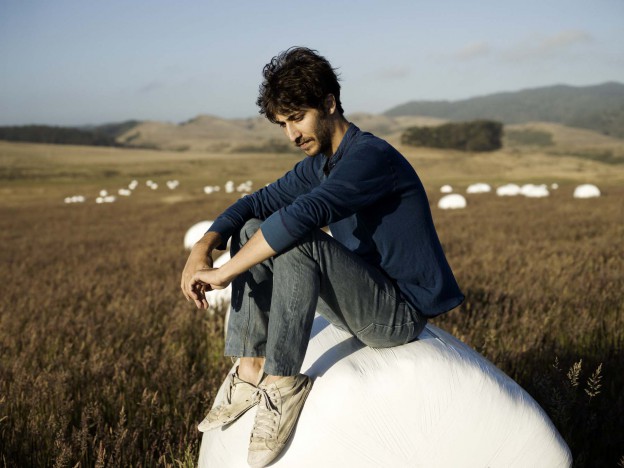
The Man Behind the Curtain
Renown Sacramento Producer Raleigh Moncrief Steps Out from Behind the Boards for His New Solo Album
A fine piece of apothegm to live by is, “you’re only as good as the company you keep.” Look at Ringo Starr. He got by with a little help from his friends, who happened to be the greatest musical minds of his time. A relevant and localized example is producer Raleigh Moncrief, who’s collaborated with Zach Hill, toured in Marnie Stern’s band and co-produced/engineered one of the most unanimously lauded albums on a national scale in the past two years.
If he lived in Brooklyn, he would get accosted by hipster vermin at every DIY show he attended. Living in Sacramento means relative anonymity, even indifference to an extent, which allows unlimited hideout time to craft a solo record while producing for the budding local bands. A hermit’s life is how creative-types get things done, and for Moncrief it means recording in his kitchen with an acoustic guitar and laptop at odd hours between sessions with Ganglians and Teddy Briggs of Appetite.
Moncrief is one of the few “behind-the-scenes” guys that has his name shouted out in press releases and in print. Contributing to Dirty Projectors’ Bitte Orca record plays a significant role in that, but this year alone he’s recorded a Ganglians record, the Appetite record and an EP with Cuckoo Chaos–those are just the ones released. Last year he sporadically released free digital beat tape EPs and remixed a few local rap artists. Without hearing Moncrief’s solo debut Watered Lawn, one might assume he’s scatterbrained or has A.D.H.D. when it comes to music, but over the phone he cleared the air with, “I like to work fast and get it out of my face or my mind.”
Listening to the advance of the Anticon debut, the many faces of Moncrief begin to blur. Even my iTunes player struggled with defining Watered Lawn, by anointing it “New Age”–the dishwater of music genres. When I shared this curiosity with Moncrief, he replied through laughter, “How the fuck did that happen?”
Defining Moncrief’s music can be quizzical; a task he sidestepped by casually stating, “That’s not my job,” but the record is not beyond comprehension. The title itself suggests a project well tended and cared for, which is properly delivered in the 38-minute duration. Written in the three-month span of December through March, Watered Lawn is the amalgamation of Moncrief’s flighty interests in mainstream hip-hop production, a bit of leftover 8-bit intrigue and his various indie collaborations whittled down into 11 songs. Last year’s Carpal Tunnels beat tape introduced Moncrief as a hip-hop producer, but as time wore on the sound began leaning toward chillwave and beat music associated with the Los Angeles scene. In our interview, he offered a slightly alternative progression.
“In my mind I owe more to mainstream hip-hop,” he said. “It’s kind of weird because I don’t really listen to that beat music so much. There are elements of it I really like. It’s really about the low end. That’s something I took away from that [scene]. But I think that T.I. was more inspiring than the beat scene.”
By March he leaked “Lament for Morning” to the blogs, which ushered in the first glimpse of a newly discovered identity. The track made sense in fluidity of past work, but the release of “I Just Saw” in late August broke his vocal silence and hinted at a friendly influence. On the track, Moncrief is twitterpated by a female vision, stretched to a joy of singing without concern to his voice’s limitations. It is a singing style often attributed to David Longstreth of Dirty Projectors.
“I can’t help but be influenced by everyone I’ve worked with,” Moncrief said. “The main thing I took away specifically from working with Dave was exploring those outer limits. Being someone who’s not afraid to go to a place that is uncomfortable for yourself. Being brave and having the courage to try something that you’re not going to be confident in is valuable.”
Tracing back to his days in instrumental post-rock bands What’s Up? and Who’s Your Favorite Son, God?, Moncrief was the silent axe man, which continued into his project with Zach Hill and playing alongside Marnie Stern. While recording his debut he described the urge to sing as something growing in his mind, a new challenge to go along with his newly discovered production style. “I’ve written things and had other people sing them,” he said. “It reached a point where it felt like doing it myself was something I needed to prove I was capable of.”
“Lament for Morning” was the first leak, but the track that was his breakthrough was “Cast Out for Days,” which achieves a balance of the organic instruments (guitar and vocals) alongside warping glitches, flickering synths and programmed drums. “To me, [“Lament for Morning”] still sticks out like a sore thumb on the record,” he said. “Originally it was a guitar piece that was instrumental, but I didn’t know if it fit. So I just changed the guitar parts to vocals. That was my vain attempt at making it fit contextually.”
With new discovery can come bothersome uncertainty, but relating back to ol’ Ringo, one gets by with help from their friends. Moncrief had his share of butterflies. He sent his music out to the hodge-podge of contacts and friends he accumulated in the industry, including label heads at Anticon who initially balked at his beats. “I’d send them out to friends and say, ‘How does this make you feel?’
“I was looking for reinforcement because when you’re isolated like that it’s hard to have perspective,” he said. “Which is something good about the isolation as well. I got a lot of good feedback that helped build confidence in pursuing the change, because it’s a pretty big departure from most everything I’ve done previous.”
Oddly enough, it took a blog post instead of a personal e-mail to get Anticon’s attention. The label head contacted Moncrief and offered him a record deal. The label even sent Watered Lawn to Los Angeles to be mastered by Daddy Kev, owner of Alpha Pup Records and founder of Low End Theory, a weekly club night featuring experimental hip-hop–ask any Low End theorist or resident and they’ll say it’s an honor to receive his visionary stamp of approval. Raleigh could only say in approval, “He made it loud. Good work, Daddy Kev.”
The record awaits an Oct. 25 release date, but Moncrief is not taking a breather from issuing personal challenges. He has a few California tour dates, mostly coastal, scheduled sooner than he’d probably prefer. It will be his first opportunity to debut his songs, as well as perform with a four-piece band, which was lacking completion at the time of our interview. “It’s short notice,” he said. “It’s coming together well, but there’s still a lot to be done before I’d feel confident performing, which is funny because I think there’s a show in two weeks? Three weeks?”
As sketchy as he said he felt, it also seemed as though the pieces would fall into place regardless. Moncrief lamented it was tough to find people to play, but perhaps he will call in a few more friendly favors.
Look for Watered Lawns from Anticon Records on Oct. 25, 2011.



